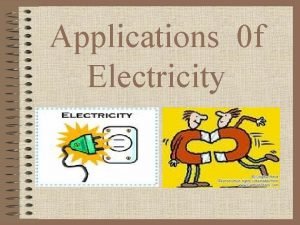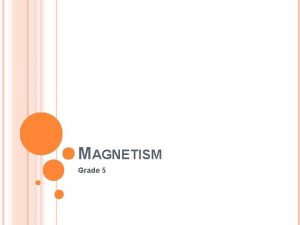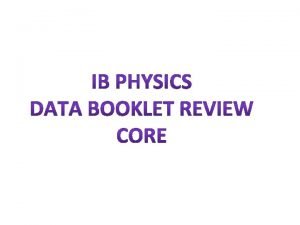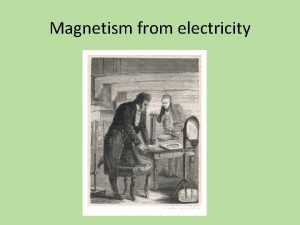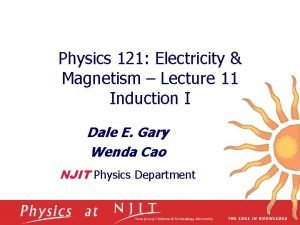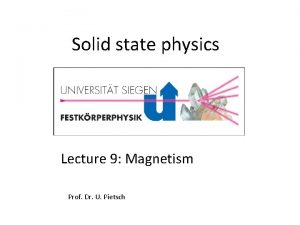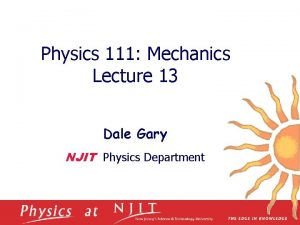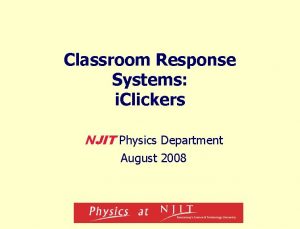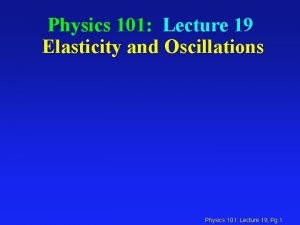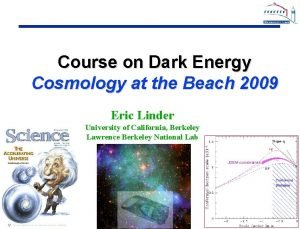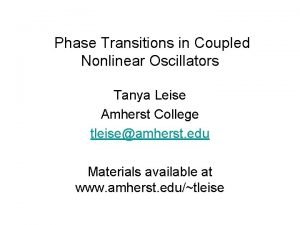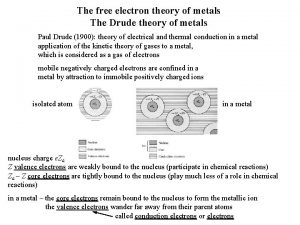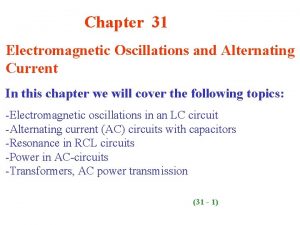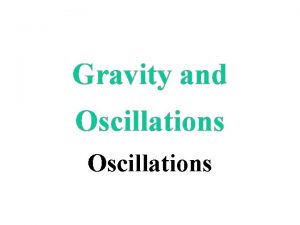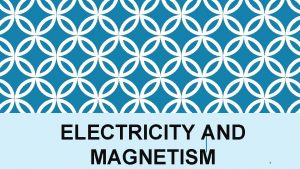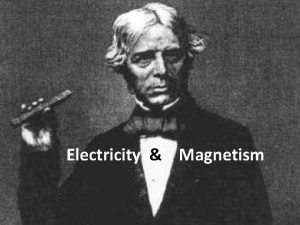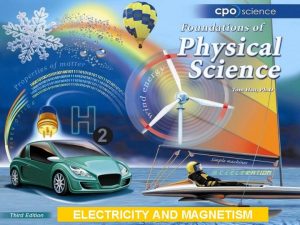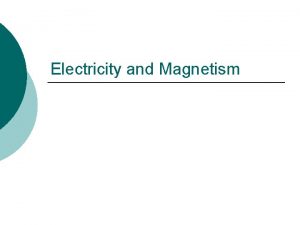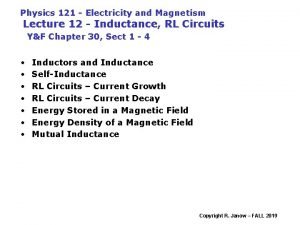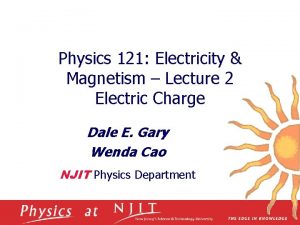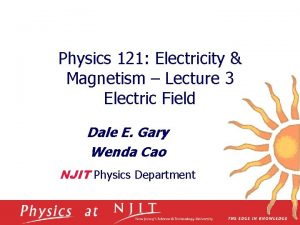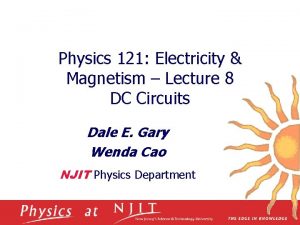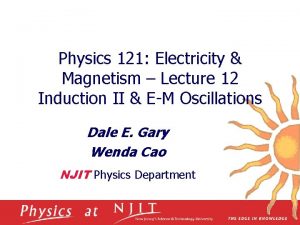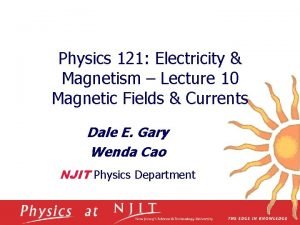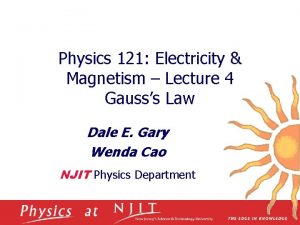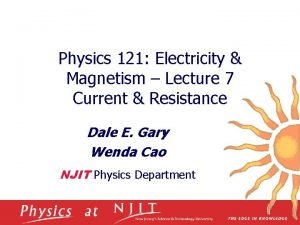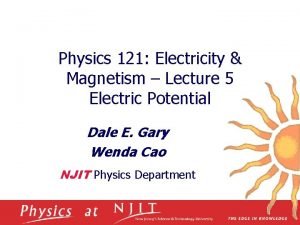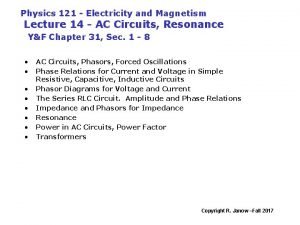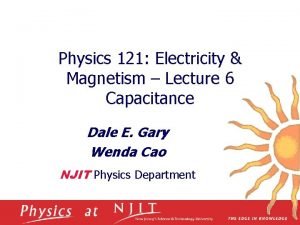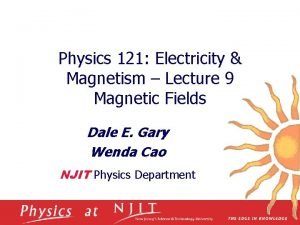Physics 121 Electricity Magnetism Lecture 13 EM Oscillations

























- Slides: 25

Physics 121: Electricity & Magnetism – Lecture 13 E-M Oscillations and AC Current Dale E. Gary Wenda Cao NJIT Physics Department

Electromagnetic Oscillations December 5, 2007

Oscillating Quantities q q We will write oscillating quantities with a lower-case symbol, and the corresponding amplitude of the oscillation with upper case. Oscillating Quantity Amplitude Voltage v V Current i I Charge q Q Examples: December 5, 2007

Derivation of Oscillation Frequency We have shown qualitatively that LC circuits act like an oscillator. q We can discover the frequency of oscillation by looking at the equations governing the total energy. q q Since the total energy is constant, the time derivative should be zero: But and , so making these substitutions: q This is a second-order, homogeneous differential equation, whose solution is q i. e. the charge varies according to a cosine wave with amplitude Q and frequency w. Check by taking two time derivatives of charge: q Plug into original equation: q December 5, 2007

Which Current is Greatest? 1. The expressions below give the charge on a capacitor in an LC circuit. Choose the one that will have the greatest maximum current? A. q = 2 cos 4 t q = 2 cos(4 t+p/2) q = 2 sin t q = 4 cos 4 t q = 2 sin 5 t B. C. D. E. December 5, 2007

Time to Discharge Capacitor 2. The three circuits below have identical inductors and capacitors. Rank the circuits according to the time taken to fully discharge the capacitor during an oscillation, greatest first. A. I, III. II, I, III, I, II. III, I. B. C. D. E. III. December 5, 2007

Charge, Current & Energy Oscillations The solution to the equation is , which gives the charge oscillation. q From this, we can determine the corresponding oscillation of current: q q And energy q But recall that , so . That is why our graph for the energy oscillation had the same amplitude for both UE and UB. q Note that q Constant December 5, 2007

Damped Oscillations Recall that all circuits have at least a little bit of resistance. q In this general case, we really have an RLC circuit, where the oscillations get smaller with time. They are said to be “damped oscillations. ” q q Then the power equation becomes Power lost due to resistive heating q As before, substituting and gives the differential equation for q Solution: Damped Oscillations December 5, 2007

Resonant Frequency 3. How does the resonant frequency w for an ideal LC circuit (no resistance) compare with w’ for a non-ideal one where resistance cannot be ignored? A. The resonant frequency for the non-ideal circuit is higher than for the ideal one (w’ > w). The resonant frequency for the non-ideal circuit is lower than for the ideal one (w’ < w). The resistance in the circuit does not affect the resonant frequency—they are the same (w’ = w). B. C. December 5, 2007

Alternating Current q q q The electric power out of a home or office power socket is in the form of alternating current (AC), as opposed to the direct current (DC) of a battery. Alternating current is used because it is easier to transport, and easier to “transform” from one voltage to another using a transformer. In the U. S. , the frequency of oscillation of AC is 60 Hz. In most other countries it is 50 Hz. The figure at right shows one way to make an alternating current by rotating a coil of wire in a magnetic field. The slip rings and brushes allow the coil to rotate without twisting the connecting wires. Such a device is called a generator. It takes power to rotate the coil, but that power can come from moving water (a water turbine), or air (windmill), or a gasoline motor (as in your car), or steam (as in a nuclear power plant). December 5, 2007

RLC Circuits with AC Power q When an RLC circuit is driven with an AC power source, the “driving” frequency is the frequency of the power source, while the circuit can have a different “resonant” frequency. Let’s look at three different circuits driven by an AC EMF. The device connected to the EMF is called the “load. ” q What we are interested in is how the voltage oscillations across the load relate to the current oscillations. q We will find that the “phase” relationships change, depending on the type of load (resistive, capacitive, or inductive). q December 5, 2007

A Resistive Load Phasor Diagram: shows the instantaneous phase of either voltage or current. q For a resistor, the current follows the voltage, so the voltage and current are in phase (f = 0). q q If q Then f December 5, 2007

Power in a Resistive Circuit 4. A. B. C. D. E. The plot below shows the current and voltage oscillations in a purely resistive circuit. Below that are four curves. Which color curve best represents the power dissipated in the resistor? The green curve (straight line). The blue curve. The black curve. The red curve. PR None are correct. t December 5, 2007

A Capacitive Load q For a capacitive load, the voltage across the capacitor is proportional to the charge q But the current is the time derivative of the charge q In analogy to the resistance, which is the proportionality constant between current and voltage, we define the “capacitive reactance” as q So that q The phase relationship is that f = -90º, and current leads voltage. . December 5, 2007

An Inductive Load q For an inductive load, the voltage across the inductor is proportional to the time derivative of the current q But the current is the time derivative of the charge q Again in analogy to the resistance, which is the proportionality constant between current and voltage, we define the “inductive reactance” as q So that q The phase relationship is that f = +90º, and current lags voltage. . December 5, 2007

Units of Reactance 5. We just learned that capacitive reactance is and inductive reactance is. What are the units of reactance? A. Seconds per coulomb. Henry-seconds. Ohms. Volts per Amp. The two reactances have different units. B. C. D. E. December 5, 2007

Summary Table Circuit Element Symbol Resistance or Reactance Phase of Current Phase Constant Amplitude Relation Resistor R R In phase with v. R 0º (0 rad) VR=IRR Capacitor C XC=1/wd. C Leads v. R by 90º -90º (-p/2) VC=ICXC Inductor L XL=wd. L Lags v. R by 90º +90º (p/2) VL=ILXL December 5, 2007

Summary q Energy in inductor: Energy in magnetic field LC circuits: total electric + magnetic energy is conserved q LC circuit: Charge equation Current equation Oscillation frequency q q LRC circuit: Charge equation Reactances: q Resistive, Oscillation frequency capacitive, inductive December 5, 2007

Thoughts on Clickers 6. How did you like using the clickers in this class? A. Great! It had its moments. I could take it or leave it. I would rather leave it. It was the worst! B. C. D. E. December 5, 2007

Thoughts on Clickers 7. Which answer describes the most important way that the clicker aided you in learning the material? A. It helped me to think about the material presented just before each question. It broke up the lecture and kept me awake. It tested my understanding. It provided immediate feedback. It showed me what others were thinking. B. C. D. E. December 5, 2007

Thoughts on Clickers 8. Which answer describes the second most important way that the clicker aided you in learning the material? A. It helped me to think about the material presented just before each question. It broke up the lecture and kept me awake. It tested my understanding. It provided immediate feedback. It showed me what others were thinking. B. C. D. E. December 5, 2007

Thoughts on Clickers 9. How would you react to clickers being used in other classes at NJIT? A. I I I B. C. D. E. think it would be excellent. think it is a good idea. wouldn’t mind. would rather not. definitely hope not. December 5, 2007

Thoughts on Clickers 10. What problems did you have with your clicker? A. I had no problems with my clicker. It was too big or bulky, a pain to carry around. I had trouble remembering to bring it to class. My clicker had mechanical problems. I lost or misplaced it (for all or part of the semester). B. C. D. E. December 5, 2007

Thoughts on Clickers 11. If you had the choice between using a clicker versus having a lecture quiz where you had to fill in a scantron, which would you prefer? A. I would prefer the clicker. I would prefer the scantron quiz. B. December 5, 2007

Have a Nice Day 12. Please click any button on your clicker as you turn your clicker in. This will register your name as having turned in your clicker. December 5, 2007
 Electricity and magnetism lecture notes
Electricity and magnetism lecture notes Ib physics topic 5 question bank
Ib physics topic 5 question bank 4 forces of nature
4 forces of nature How are static electricity and current electricity alike
How are static electricity and current electricity alike Magnetism and electricity
Magnetism and electricity Electricity and magnetism
Electricity and magnetism Electricity jeopardy
Electricity jeopardy Magnetism grade 5
Magnetism grade 5 Electricity and magnetism
Electricity and magnetism Sph3u electricity and magnetism
Sph3u electricity and magnetism Electricity and magnetism
Electricity and magnetism Electricity and magnetism
Electricity and magnetism Electromagnet experiment hypothesis
Electromagnet experiment hypothesis Electric fuse and circuit breaker graphic organizer
Electric fuse and circuit breaker graphic organizer Current electricity
Current electricity Static electricity and current electricity
Static electricity and current electricity Magnetism
Magnetism Conceptual physics magnetism
Conceptual physics magnetism Njit kepler
Njit kepler Njit physics department
Njit physics department Elasticity and oscillations
Elasticity and oscillations Baryon acoustic oscillations
Baryon acoustic oscillations Tanya leise amherst
Tanya leise amherst Plasma oscillations
Plasma oscillations Joint mobilization definition
Joint mobilization definition Electromagnetic oscillations and alternating current
Electromagnetic oscillations and alternating current





